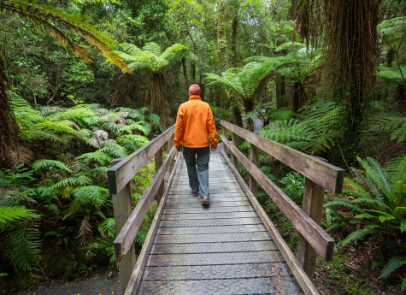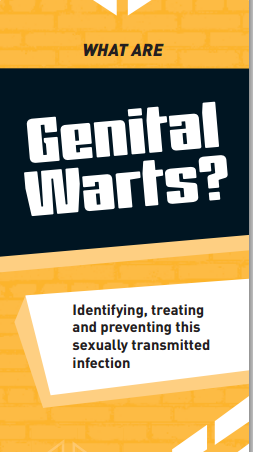Genital warts
Key points about genital warts
- Genital warts are small fleshy lumps of abnormal skin that can grow on and around your genitals.
- They're caused by the human papillomavirus (HPV) which is very common and usually passed on through skin-to-skin contact.
- Most people with HPV infection don't develop warts, but the virus can still be spread to other people even without having warts.
- See your doctor if you think you might have them, or if you've had sexual contact with someone who has HPV or genital warts.
- Treatment is available but the most effective way to prevent genital warts is vaccination against HPV. This is funded for all New Zealanders 9–26 years old.

Genital warts are caused by the human papillomavirus (HPV). They are commonly passed on through:
- direct skin-to-skin contact including vaginal or anal sex – you don’t need to have penetrative sex to pass on the virus
- sharing sex toys
- oral sex (rare)
- from mother to baby during vaginal delivery (rare).
Most people with HPV don’t know they have it. Once you have been in contact with HPV, genital warts can take months or even years to develop. However, you can spread the virus to other people even if you haven't yet developed warts (but you are more likely to spread the virus with active warts).
There are more than 100 strains of HPV, 40 of which affect your genitals. The strains that cause warts on your genitals are type 6 and 11. These are known as low-risk types of HPV.
High-risk types of HPV (especially type 16 and 18) can cause abnormal cell changes of your cervix and lead to cervical cancer. This is why women should have regular HPV screening. Read more about HPV and HPV screening.
Most people who come in contact with HPV will not develop genital warts. If you do develop warts, it could happen months or even years, after you first came into contact with the virus.
Genital warts appear as fleshy bumps or growths found on and around your genital area. They vary in size and shape and can be described as:
- small or large
- raised or flat
- single or multiple (which can take a cauliflower appearance)
- inside or surrounding your vagina or cervix
- on your scrotum or penis
- inside or surrounding your anus.
Genital warts are usually painless, although in rare cases they can become itchy, inflamed and cause bleeding. See images of genital warts.(external link)
See your doctor if you think you might have genital warts, or if you have had sexual contact with someone who has HPV or genital warts.
Your doctor will need to examine your genitals to diagnose genital warts. Warts have a classic appearance, which means they can be diagnosed just by looking at them. Sometimes, a sample (biopsy) of the wart may be taken to rule out other causes if the appearance is not typical.
If you have genital warts, your doctor may also check for other sexually transmitted infections (STIs) or do a sexual health check. Read more about STIs.
Treatment is only recommended if the symptoms of genital warts are disturbing, eg, they cause pain, inflammation, bleeding or embarrassment. Your healthcare provider may recommend no treatment if your warts don’t cause any symptoms or problems. Warts can go away without treatment in about 30% of people over a 6-month period.
Treatment for genital warts depends on several factors such as the size and number of warts, the location, whether you are pregnant and your sex. Your healthcare provider will discuss the treatment options with you depending on your condition. A combination of different treatments may be recommended.
The 2 main types of treatment for genital warts are applying a cream or freezing with liquid nitrogen. Talk to your doctor about which option is best for you. The decision will be based on factors such as the size and number of warts, the location, whether you are pregnant and your gender.
Cream treatment
Podophyllotoxin solution (Condyline®)
- Podophyllotoxin solution (Condyline®) is recommended for males only.
- This solution is applied directly on to the wart 2 times a day for 3 days in a row, followed by 4 days’ rest. This is one course of treatment.
- It's best to apply the solution only to the warts (avoiding the surrounding normal skin).
- If the warts are not completely better, the course of treatment for 3 days and rest for 4 days is repeated every week for up to 5 weeks.
- Most people need 4 or 5 courses of treatment.
- Podophyllotoxin solution stops the wart growing and causes it to shrivel.
- Avoid sexual intercourse during treatment.
- You may experience some irritation when you apply the liquid – this is the solution working to kill the wart tissue.
- Read more about podophyllotoxin solution.
Imiquimod cream (Aldara®)
- The cream is rubbed into the wart and then washed off after 6–10 hours, eg, you can apply the cream before going to bed and wash it off in the morning.
- This should be done 3 times a week.
- It can often take several weeks of treatment before you notice an improvement.
- This treatment works by helping stimulate your immune system into attacking the warts.
- You may experience some mild irritation when you apply the cream.
- Not for use in pregnancy.
- Read more about imiquimod cream.
Freezing with liquid nitrogen (cryotherapy)
- Freezing the wart using liquid nitrogen is known as cryotherapy.
- It is usually recommended to treat multiple small warts, particularly those that develop on the shaft of your penis or on or near your vulva.
- During cryotherapy treatment, you will experience a mild to moderate burning sensation.
- Once the treatment has finished you may develop skin irritation, blistering and pain at the site of the wart.
- Your skin will take between 1 and 3 weeks to heal.
- Avoid having sex until the area of skin around the wart has fully healed.
There are other surgical procedures that can be done including:
- Laser treatment using an intense beam of light. This can be expensive, is not available in all regions of Aotearoa New Zealand and can result in scarring and pain.
- Direct removal of warts using scissors or a scalpel done under local or general anaesthetic. There may be some pain afterwards.
- Electrocautery to burn off the warts. There may be pain and swelling afterwards.
- Using a treatment solution called trichloroacetic acid to burn off warts chemically. There may be mild skin irritation, sores or pain afterwards.
Talk to your healthcare provider to find out which treatment is the best for you.
How long does genital wart treatment take?
For most people, it can take several months to remove the warts, so it's important to stay with the treatment. Although treatment can result in the disappearance of genital warts, the viral infection is not totally gone. The virus can remain dormant (inactive) in your skin after treatment.
In many cases, warts don’t come back after a course of treatment but sometimes they return after a few years.
There are things you can do, and avoid doing, to ease symptoms.
Things to do:
- Use tampons or menstrual cups rather than sanitary pads or panty liners. Particularly avoid scented and deoderised sanitary products.
- Keep cool, especially at night.
- Wear loose-fitting clothing and natural fibre underwear.
- Try cold compresses instead of scratching.
- Try a saltwater bath to soothe skin and improve healing between treatments.
Things to avoid:
- Using soaps or detergents on the affected area.
- Using any products or topical creams unless they've been prescribed for you.
- Getting urine (wee), faeces (poo) and menstrual blood on the affected areas.
- Scratching or rubbing the affected area – it will make the itching worse
- Staying in wet swimwear or clothing.
- Shaving or waxing as this may spread warts.
Most genital warts will disappear by themselves over time if untreated. If you are immunocompromised, warts are less likely to go away by themselves and are generally more difficult to treat. In 20–30% of treated cases, genital warts can regrow in a previously treated area or new area.
The most effective way to prevent genital warts is vaccination against HPV. Correct use of latex condoms greatly reduces (but does not eliminate), the risk of catching or spreading HPV, as skin-to-skin contact can happen around the condom.
The HPV vaccine (Gardasil 9)
The HPV vaccine protects against 9 different strains of HPV including:
- types 6 and 11, which cause around 90% of genital warts
- types 16 and 18, which are linked to more than 70% of cases of cervical cancer.
In Aotearoa New Zealand, the HPV vaccine is available free for everyone aged 9–26 years (males and females). Women and men of any age can still have the vaccination by visiting their family doctor and discussing whether it would be of benefit to them and how much it will cost.
The HPV vaccine is only able to prevent HPV infection; it does not treat the infection. For best protection, girls and boys need to be vaccinated before they are likely to be exposed to HPV, which means before they start having any sexual contact.
Read more about the HPV vaccine.
Video: Should You Get the HPV Vaccine?
This video may take a few moments to load.
(Michael Evans and Mercury Films Inc, 2012)
If you think you have genital warts or any other sexual health concerns, you can see or talk to your healthcare provider. Other places you can get help are:
Sexual health clinics(external link)
Sexual Wellbeing Aotearoa clinics(external link)
Genital warts(external link) The HPV Project, NZ
Some questions and answers about HPV and genital warts(external link) The HPV Project, NZ
Genital warts(external link) NZ Sexual Health Society
Genital warts(external link) Health New Zealand | Te Whatu Ora
Genital warts(external link) HealthInfo Canterbury, NZ
Genital warts(external link) NHS, UK
References
- Human Papilloma Virus (HPV)(external link) Auckland Regional HealthPathways, NZ
- Guidelines for the management of genital, anal and throat HPV infection in NZ(external link) The HPV Project, NZ, 2017
- Genital warts(external link) The HPV Project, NZ
- Genital warts(external link) HealthInfo Canterbury, NZ
- Anogenital warts(external link) DermNet, NZ
- Genital warts(external link) NHS, UK
- Genital warts(external link) Mayo Clinic, US, 2022
- Genital warts(external link) 3D HealthPathways, NZ
- Genital warts(external link) STI management guidelines NZ
Clinical resources
Guidelines for the management of genital, anal and throat HPV infection in NZ(external link) The NZ HPV Project, 2017
Genital warts and HPV vaccine – don’t miss an opportunity to offer vaccination(external link) Goodfellow MedCases, NZ, 2019
HPV vaccination – getting the programme back on track(external link) BPAC, NZ, 2019
Anogenital wart(external link) DermNet NZ, 2015
Continuing professional development
Video: Goodfellow Unit MedTalk: Can HPV vaccines eliminate genital warts
HPV vaccines and their impact on clinical outcomes are discussed by Dr Grace Lee, Deputy Director Goodfellow Unit and Associate Professor Nikki Turner, academic General Practitioner and the Director of the Immune Advisory Centre. This video may take a few moments to load.
(Goodfellow MedTalks, NZ, 2019)
Brochures

HealthEd, NZ, 2022
Credits: Healthify editorial team. Healthify is brought to you by Health Navigator Charitable Trust.
Reviewed by: Dr Phoebe Hunt, sexual health registrar, Auckland DHB
Last reviewed:
Page last updated:





